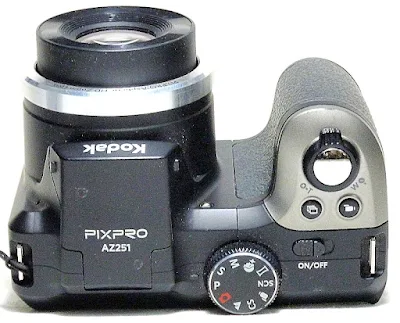Another recent acquisition, part of my interest in the 'Re-Living the CCD Sensor' series, is the Kodak PixPro AZ251, a 25x superzoom digital bridge camera with a 16MP CCD sensor. The AZ251 (with the AZ abbreviated from 'Astro Zoom'), manufactured under license by JK Imaging, was launched in 2013 as an update to the Kodak PixPro series that started with the launch of the PixPro AZ651.
The entry-level bridge camera, with an optical zoom lens equivalent to 24-600mm on a 35mm full-frame camera, also features optical image stabilization, a 3-inch 230k rear LCD screen, 720p HD video recording, full auto and PSAM modes, panorama and HDR, several scene modes, and digital filters for more creative control.
Not seen on the camera, however, is an EV, which is common among digital bridge cameras of that era. The missing component detracts the camera from having the look and its use as a full SLR look-alike and relegates it to more of an enlarged electronic compact with a superzoom lens and a comfortable to-hold rubberized handgrip.
The true strength of the camera, however, lies with its ease of use, features that you can grow your photography with, an ultra-wide angle with a close focusing distance of just 3cm to a 600mm equivalent super telephoto lens, and a superb 16MP CCD sensor that delivers well-saturated color-rich images normally associated with the Kodak brand.
Extending the ease of use of the camera is the power requirement of a set of easily available 4x AA (Ni-MH or Alkaline) batteries, with the Alkaline rated for up to 280 shots according to CIPA test results. A run-of-the-mill USB cable is all that is needed to connect the camera to either a printer or computer, and images can be stored on the camera's 8MB of internal memory, or on SD/SDHC cards with up to 32GB memory.
Exposure Modes
The main exposure mode functions are centered around the Mode Dial located on the top plane of the camera, where you access the Auto and PSM (Program AE, Shutter Priority, Manual) shooting modes, as well as selections for Face Beautifier, Panorama, Scenes, Movie, Custom, and Landscape. On the top plane are also buttons for continuous shooting and video recording, as well as the zoom rocker, shutter release, and Power On/Off slider.
Scenes, when set on the Mode Dial, provide options Auto Scene, Sport, Beach, Sunset, Fireworks, Night Landscape, Sketch, Snow, Children, ID, Glass, Photo Frame, Panning Shot, Portrait, Fish Eye, Party, Indoor, Leaf, Museum, Night Portrait, Pet Mode-Dog, and Pet Mode-Cat. Each sub-set scene menu is accompanied by a pair of before-and-after images which are self-explanatory for each sub-mode selection.
On the back, aside from the LCD screen, the exposure compensation button also gives access to ISO, aperture, and shutter speed selections, depending on what shooting mode the camera is set to, while the 'i' button gives access to image filters. Next to it is the Menu button, which accesses the 1-page menu selection (Exposure Metering, Image Size, Image Stabilization On/Off, Continuous Mode AF, HDR) and a further dropdown link to access camera Settings (Quality, AF Assist Beam, Digital Zoom, ...)
The D-pad, with the Set button in the middle, gives access to AF (Single AF, Multi AF, and Object Tracking) Shooting Modes, Macro On/Off, Flash Auto/Off, Self-timer, and Delete Image (in Playback Mode). Located below the D-pad are the Playback, and LCD Display Option (Classic, Full, Off) buttons.
Early Images
The images should speak for themself here.
The AZ251, a low-cost buy, may not be the perfect example of what a digital camera should be, but suffice it to say, that it is an above-average performer that should keep users happy with the sharp and fine images rendered by the CCD sensor. It is a well-built camera ready for the bumps and minor knocks of family outings, frolics in the park, adventure tracks and trials, and the sun by the sea.































No comments:
Post a Comment